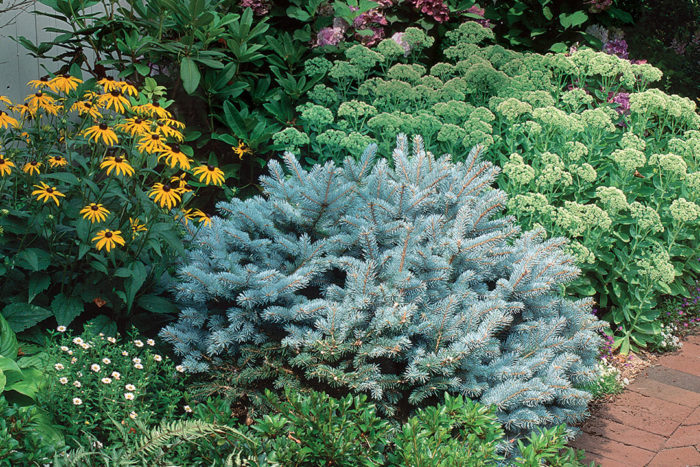
Ever since my love affair with colorful dwarf conifers began, I’ve taken a lot of kidding from my friends in the plant world, many of whom regard these shrubs as tacky and gaudy. They all love small deciduous shrubs for their usefulness, attractiveness, and low maintenance requirements, but they shy away from dwarf conifers, finding them difficult to place in the landscape and fearing they will look like meatballs or strange Christmas trees. Others see small conifers as a group loved only by collectors of the unusual.
My friends couldn’t be more wrong. These plants offer colors, textures, shapes, and sizes unusual in the landscaping world. Since they add visual interest throughout the year, they’re excellent plants to use as accents and as components of major plantings. “Dwarf” is a loosely defined word, so think of them as plants that grow slowly and act as shrubs rather than as the tree species from which most are selected.
There are dwarf conifers that will flourish in every garden, regardless of zone or soil and light conditions. Most dwarf conifers like sunny, well-drained sites with slightly acidic soil. If your site does not match these characteristics, there are dwarf conifers for other conditions as well. Taxus and Chamaecyparis are two genera that tolerate shade. Picea pungens cultivars tolerate drought and alkaline soil. To be sure, ask at a garden center which dwarf cultivars do well in your area.
Unfortunately, the names of dwarf conifers are often confused in nurseries. Protect yourself when shopping by making sure the plant is indeed slow-growing. It should be very dense, with short internodes, indicating that it is not growing more than several inches a year. Avoid it if it looks open, which shows that it is growing quickly. Faster-growing plants are less expensive but rapidly outgrow their space.
Add a cooling effect with blues and silvers
The blues and silvers of conifers are not found anywhere else among woody plants. These shimmering hues add a cooling effect and combine beautifully with pinks, yellows, purples, and blacks. Although silvery-blue conifers make effective specimens, I prefer to use them in bold masses or in drifts to unify plantings and provide structural continuity.
Picea pungens ‘Glauca Pendula’
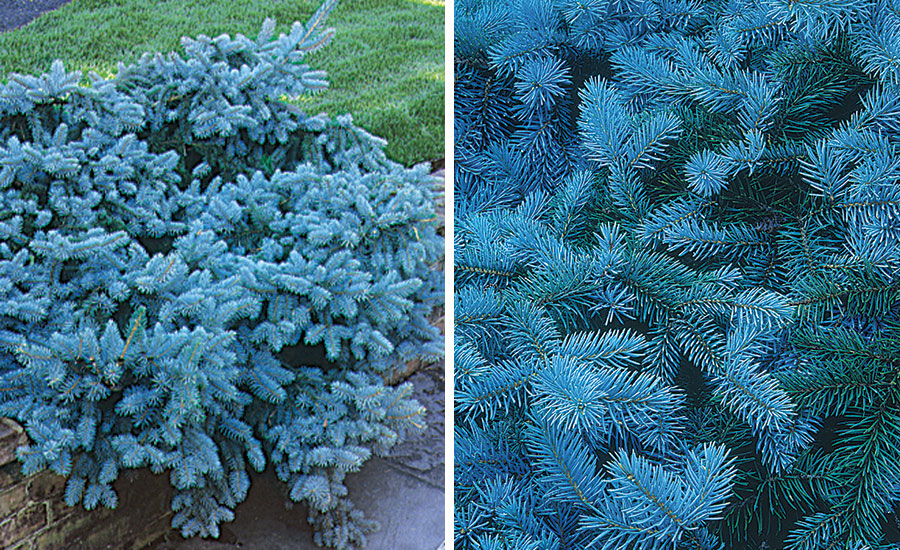
We’ve all seen how strong blue Colorado spruces (Picea pungens f. glauca) are in the landscape, usually standing by themselves in a plain of turf, an association that does little to flatter either partner. Now think how this striking color and crisp, sharp texture could add spark to a perennial border.
Low-growing Colorado spruce (Picea pungens ‘Glauca Pendula’, USDA Hardiness Zones 3–8) grows 3 or 4 inches a year, eventually spreading to about 8 feet wide and 4 feet tall, with silvery needles like its parent species.
I recommend using several and surrounding them with pink Japanese anemones (Anemone huphehensis var. japonica) or a ground cover of pink verbena (Verbena ‘Sissinghurst’ or Verbena ‘Apple Blossom’).
Abies koreana ‘Silberlocke’
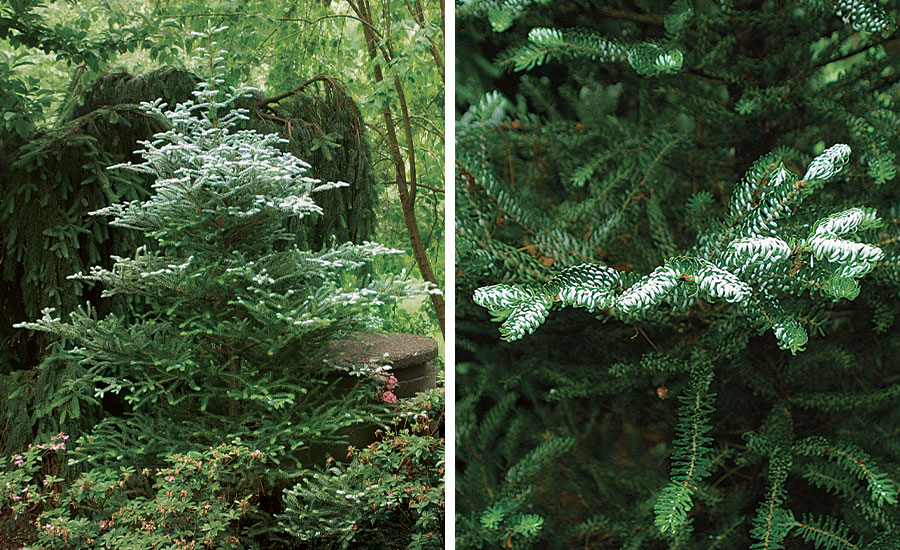
Dwarf Korean fir (Abies koreana ‘Silberlocke’, Zones 5–6) slowly becomes a small tree and has strongly curved needles that turn the entire plant silver. You can expect this dwarf to grow 2 to 4 inches per year and get 4 to 5 feet tall and around 3 feet wide. The same pink and silver combination I recommend for the Colorado spruce can be repeated by tying these brilliant dwarfs to the surrounding perennials with a purplish vine, such as Spanish flag (Ipomoea lobata) or purple bell vine (Rhodochiton atrosanguineus). To match it with a perennial, try Geranium sanguineum var. striatum.
Picea pungens ‘Montgomery’

Montgomery spruce (Picea pungens ‘Montgomery’, Zones 3–8) is a short, squat spruce that grows 3 to 4 inches a year and can eventually reach 6 feet tall and 8 feet wide. I once saw one of these silvery dwarfs with a hyacinth bean (Lablab purpureus) climbing up its side at Wave Hill, a public garden in the Bronx. The bean, with purplish leaves, flowers, and broad pods, contrasted perfectly with the low spruce. You can also plant ‘Blackie’ sweet potato vine (Ipomoea batatas ‘Blackie’) and blue fescue (Festuca glauca) at its base to continue the purple-black-silver combo.
Thujopsis dolabrata
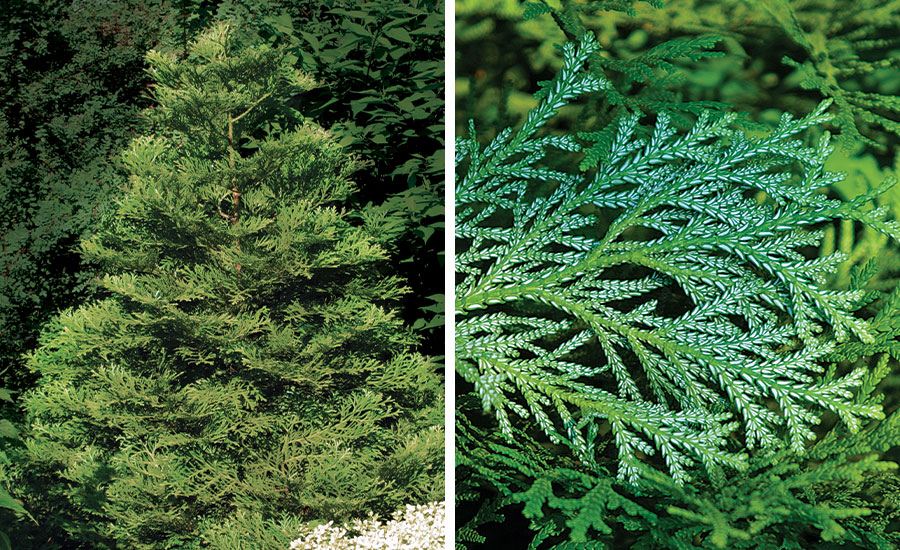
Thujopsis dolabrata (Zones 5–7) offers seductive glimpses of silver. Its green foliage has bright silvery bands underneath. As with Marilyn Monroe’s dress in The Seven Year Itch, brief glimpses of the underside on windy days can be a thrill, adding movement and light in the garden. Unlike most silvery conifers, which demand strong light, this one does best in light shade. Because of this, it is less likely to be smothered by surrounding plants. It has a Christmas-tree shape and grows 4 to 8 inches a year. It probably won’t get any taller than 10 feet, with a spread half as wide, although you may see it listed as growing much taller. Contrast its rather fine texture with something bolder like Allegheny spurge (Pachysandra procumbens).
Use yellow foliage to brighten
Whereas silver is one of the most envied of the foliage colors, yellow is the most feared. Experts have inexpertly warned that yellow foliage looks sickly or sun-scalded and should be avoided at all costs. But stop and think: We love yellow flowers, so why not yellow foliage, which we can enjoy all year round? I often use yellow-needled conifers to brighten dark winter landscapes. Most yellow conifers will turn green in the shade, so place them where they will receive full sunlight or, at most, light shade. Some may burn in hot, dry locations, so they prefer light shade in such climates.
Chamaecyparis pisifera ‘Filifera Aurea’

Golden threadleaf false cypress (Chamaecyparis pisifera ‘Filifera Aurea’, Zones 4-–8) has an interesting texture. The fine, drooping, vibrant-yellow foliage on this large shrub gives it the appearance of a shaggy dog. It grows 4 to 6 inches a year, and after about 10 years it can reach 6 feet tall and 5 feet wide. Eventually it can become 30 by 20 feet. This strong yellow is striking in a group, so, instead of using just one, plant at least three. The grouping looks intentional and brightens any spot you place it. There are two ways you can go with combinations. You can surround the grouping with dark plants for contrast. Green and black mondo grass (Ophiopogon japonicus and O. planiscapus ‘Nigrescens’) come to mind, as do Ajuga reptans ‘Burgundy Glow’, purple Sedum telephium ‘Matrona’, or even Pachysandra terminalis. Or you can go wild with color, pairing it with orange Mexican sunflowers (Tithonia rotundifolia), Crocosmia ‘Lucifer’, and yellow black-eyed Susans (Rudbeckia spp.).
Taxus baccata ‘Standishii’
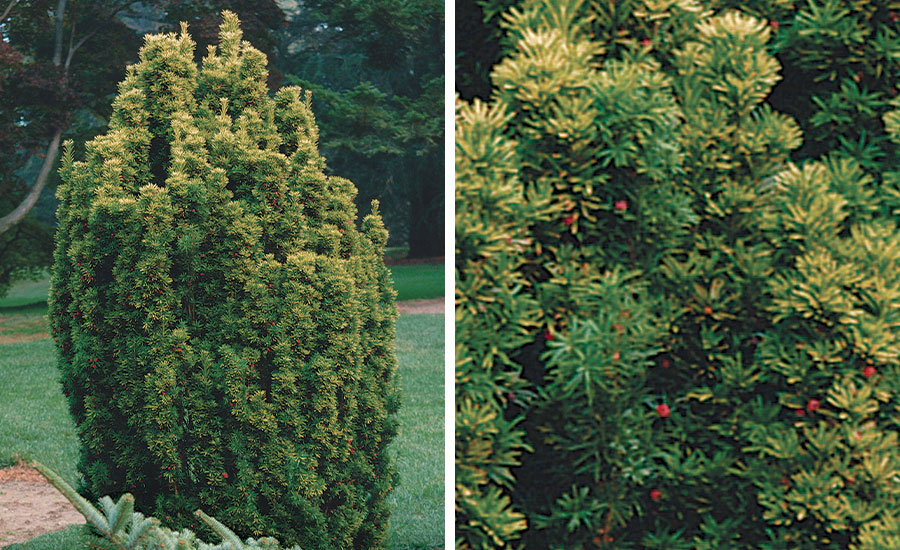
One of my favorite yellow dwarf conifers is Standish yew (Taxus baccata ‘Standishii’, Zones 7–8), a slow-growing column (1 to 3 inches per year) that never becomes much larger than 4 feet tall and 18 inches wide. For this reason, it easily serves as an evergreen accent in a perennial border. It has normal yew foliage with yellow highlights on the tips. The more sun you give this conifer, the more yellow it gets. Combine it with something low-growing that offers contrasting texture like Hedera colchica or Asarum europaeum.
Chamaecyparis obtusa ‘Nana Aurea’ and ‘Nana Lutea’
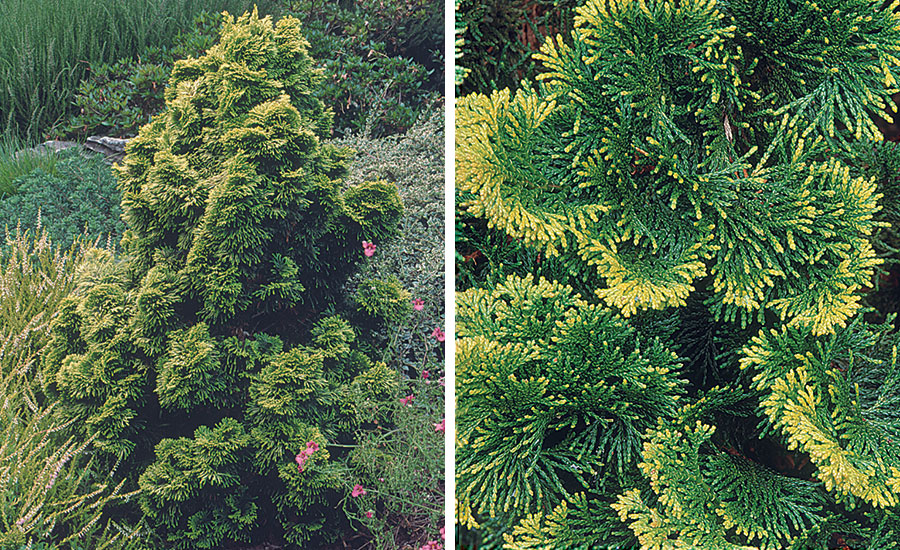
These two selections of golden mounded Hinoki false cypress (Chamaecyparis obtusa ‘Nana Aurea’ and ‘Nana Lutea’, Zones 5–8) have tight, cupped foliage with a textural effect in addition to their golden color. Both grow less than 2 inches a year and will eventually become 6 feet tall and 3 feet wide. They look great with yellow- or blue-leaved hostas.
Consider the many shades of green
Green is a color too, and not just one color. There are dark greens, light greens, and greens that change shades throughout the seasons. I recommend using green-needled conifers with white-variegated and gray plants for maximum contrast.
Chamaecyparis obtusa ‘Nana Gracilis’

The dark-green and densely branched dwarf Hinoki false cypress (Chamaecyparis obtusa ‘Nana Gracilis’, Zones 4-–8) grows equally well in sun or shade (2 or 3 inches per year). Contrast the dark green of this conifer with something bright white or silver, such as variegated ribbon grass (Phalaris arundinacea var. picta), variegated Solomon’s seal (Polygonatum odoratum ‘Variegatum’), hostas, Japanese painted fern (Athyrium niponicum var. pictum), or lamb’s ears (Stachys byzantina).
Cephalotaxus harringtoniana ‘Prostrata’
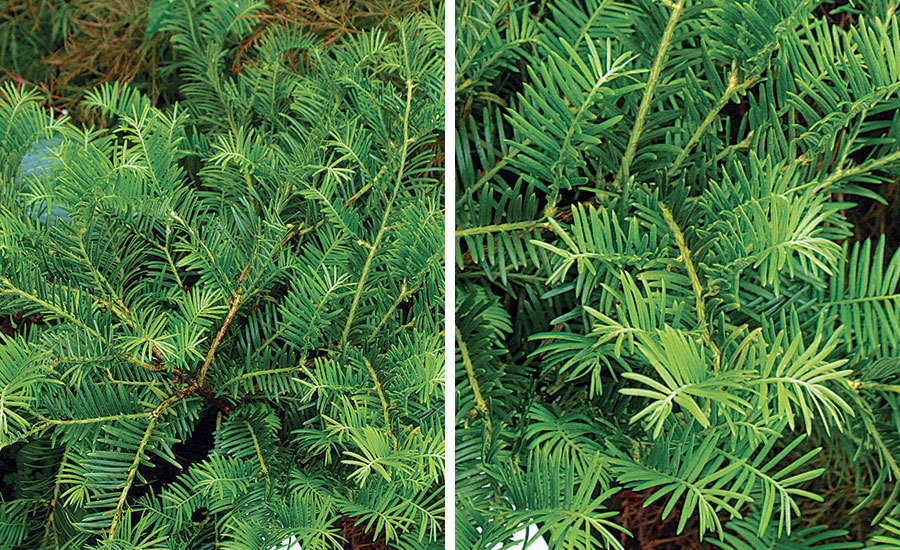
Extremely versatile in sun or shade, with the bonus of being distasteful to deer, is prostrate plum yew (Cephalotaxus harringtoniana ‘Prostrata’, Zones 6–9). This dark-green, undulating shrub, which acts like a ground cover, is a favorite of mine. I especially like its chartreuse new growth in the spring, which contrasts with the dark green of the older leaves. ‘Duke Gardens’ is a similar selection, but it holds its shoots more upright. With a growth rate of 3 to 6 inches per year, it will spread to a width of 5 feet and a height of 2 feet. It will grow under deep-rooted trees like oaks (Quercus spp.) and Kentucky coffee tree (Gymnocladus dioica), tolerating dry shade once established.
General care for these smaller-sized conifers is essentially the same as for their larger relatives:
- Water them when dry during the first year. In following years, they should be fine without supplemental water.
- Fertilizer is not needed unless the soil is unusually poor.
- Expect the same pests on the dwarfs as you see on the larger species. Spruces and firs may be attacked by mites. Bagworms target false cypresses. Fungal diseases can be a bane of pines. However, dwarfs are easier than large trees to inspect for pests. If a plant is being attacked, identify what is happening and decide if control is necessary. Extension agents and garden centers are good places to ask for help.
Once planted in your garden, some dwarf conifers may mutate or revert to the original, fast-growing species. Watch for shoots differing from the rest of the plant—faster growing or a different color or texture—and remove them as soon as you see them.
Try a dwarf conifer and I think you’ll agree with me that for small shrubs, they add a large measure of color, texture, and shape to the garden.
R. William Thomas is research horticulturist at Longwood Gardens in Kennett Square, Pennsylvania.
Fine Gardening Recommended Products

ARS Telescoping Long Reach Pruner
Fine Gardening receives a commission for items purchased through links on this site, including Amazon Associates and other affiliate advertising programs.

The Regenerative Landscaper: Design and Build Landscapes That Repair the Environment
Fine Gardening receives a commission for items purchased through links on this site, including Amazon Associates and other affiliate advertising programs.

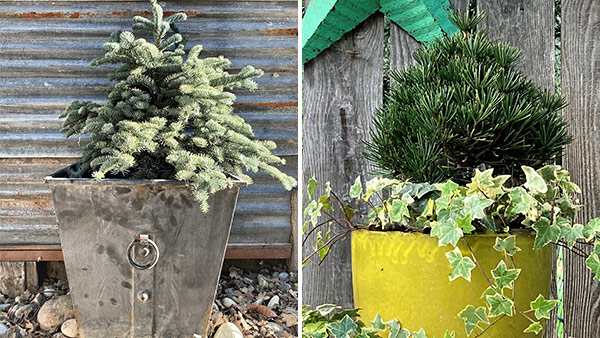
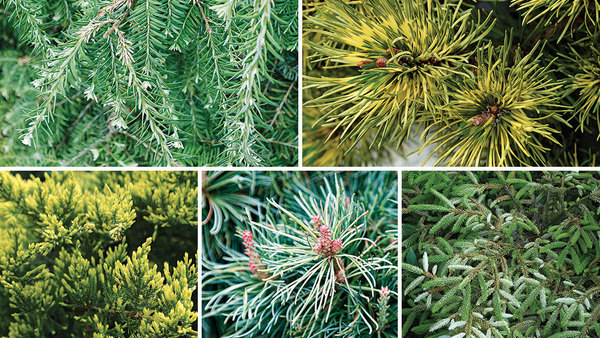
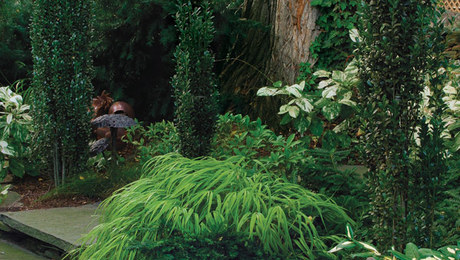
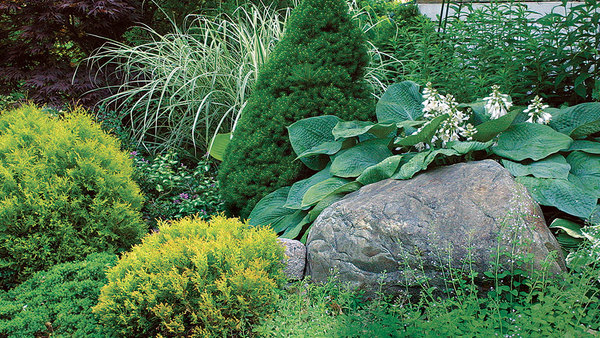














Comments
They are fabulous... In ya'lls gardens... Keep those little prolific seeders AWAY from me ( hate pine trees ) weeds to me. That's really not true... I like the wood... Ok. I need some dwarfs... Uncle.
I'll post a pic in the am to clarify my feelings. Feelings.... Nothing more than feelings.....????
Good info to know about how much dry shade the prostrate plum yew can handle, which is often a challenge in a lot of gardens.
Log in or create an account to post a comment.
Sign up Log in